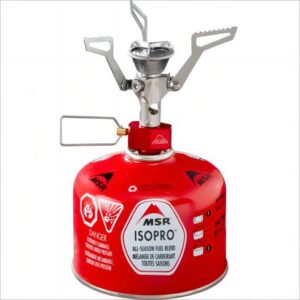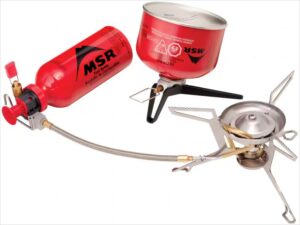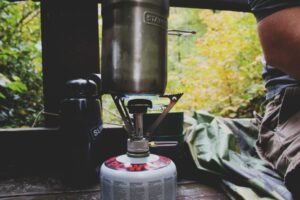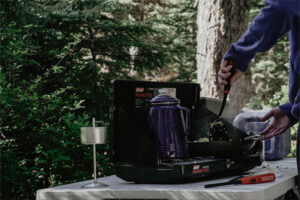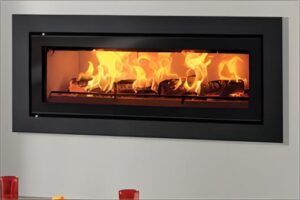
Types of Backpacking Stoves
Canister
Because of their efficiency, convenience of use, and packability, canister stoves are the most popular variety among hikers. Canisters of fuel (usually available in 4-, 8-, and 16-ounce quantities) are prefilled with a pressurized mixture of isobutane and propane. Simply screw the canister into the stove, open the valve, and light the burner (some canister stoves even have an igniter). It’s as simple as that. Canister stoves burn very cleanly and are the most efficient way to boil water; some are also capable of simmering. Furthermore, they are often lighter and smaller than liquid fuel stoves. The canister stove is an excellent solution for trekkers who want to maximize space and efficiency.
Pros:
- Boils a cup of water in 1 minute and 20 seconds;
- IsoPro fuel canisters are widely available at sporting goods stores.
- The flame may be adjusted for more accurate cooking or boiling.
- Reasonably priced;
- Simple to use.
Cons:
- Canisters are hefty, even when empty;
- Fuel canisters aren’t cheap: a tiny 5-ounce version costs roughly $6 and will probably only last for a weekend trip if feeding two people.
- It is difficult to recycle empty canisters. You must expel any residual gas, drill a hole in the canister, and recycle it.
- Does not function in temps below 20oF (give or take).
Liquid Fuel
Canister stoves are perhaps the most common choice among travelers, although liquid and multi-fuel stoves are also viable options. These versions include a refillable fuel container that connects to the stove via a fuel line. White gas, a highly refined, clean-burning fuel that can be found at most outdoor and hardware stores (and is less costly per ounce than canister fuel), powers all liquid burners. Some liquid fuel stoves may burn a variety of fuels, such as kerosene and unleaded gasoline.
As a result, liquid and multi-fuel stoves are perfect for international travel since you’ll be able to locate an adequate fuel source almost anywhere (though white gas is always the most efficient and cleanest-burning alternative). Liquid fuel also outperforms isobutane/propane at cold temperatures and at altitude, and white gas burns hotter. Furthermore, white gas is a considerably superior alternative for longer travels because it allows you to transport more with less mass and even keep your backup supply in a lightweight plastic bottle (just don’t confuse it for water!). But perhaps our favorite advantage is how it reduces waste—you can buy liquid gasoline in bulk and reuse the same fuel container again and over. To summarize, liquid fuel is an excellent alternative if you will be going overseas, hiking for lengthy periods, or cooking in chilly areas.
Pros:
- 2 minutes 45 seconds to boil a cup of water.
- Extremely adaptable: it can run on a variety of fuels.
- The flame may be adjusted for more accurate cooking or boiling.
- Reusable dedicated bottles (available separately), and white gas comes in readily recyclable cans.
- Can be used in temperatures much below freezing.
- White gas burns cleanly and is inexpensive: roughly $11.50 for a gallon, which will last for several journeys.
Cons:
- The stove and fuel bottles are large and hefty.
- Liquid fuel stoves are not inexpensive.
- White gas is more difficult to get than IsoPro canisters; you may have to look around.
- They require more maintenance than other types of stoves.
Alternative Fuel
If you’re searching for something unique, consider an alcohol, wood-burning, or solid fuel tablet stove. These stoves are popular among minimalists and ultralight enthusiasts because they are simple, lightweight, and economical. Alcohol stoves are built by cutting holes along the lip of a tuna fish or a cut-off soda can and burn denatured alcohol (which can be bought practically anyplace). Solid fuel tablet stoves are powered by lightweight tablets that burn for around 12 minutes apiece.
Pros:
- The stove and fuel are both extremely light, weighing only 180 grams for the stove and.5 oz each fuel cube.
- Bring only what you need in terms of gasoline.
- No need to transport large empty gasoline canisters.
- Simple to use: simply unwrap a tablet and light it.
- Fuel and stoves are cheap: 12 half-ounce cubes are $9, and the Esbit stove is $13.
- Tablets ignite quickly and burn consistently in any temperature, including sub-zero temperatures.
- Tablets come in a variety of sizes.
- White gas burns cleanly and is inexpensive: roughly $11.50 for a gallon, which will last for several journeys.
Cons:
- Fuel tablets smell strongly of fish before being burnt (they must be carried in a zip-top bag).
- You usually have to utilize the entire tablet.
- Don’t burn cleanly: Char will accumulate on the bottom of your pot.
- Produces waste: pills are individually packaged in foil-lined plastic like candy bars, making recycling difficult, if not impossible.
- No temperature control, thus it’s perfect for merely boiling water.
Which backpacking stove should you buy?
Before choosing a camping stove, you need think about a few accessories. Weight, fuel economy, fuel type, and boil time, as well as the size of your party, will all influence your choice of stove. Canister stoves and remote canister stoves win hands-down if you’re a solitary traveler and weight is an issue. If you’re trekking to a high altitude, avoid remote canister stoves since they don’t work as well up there.
Liquid fuel stoves are the clear winner for individuals traveling worldwide and needing a stove that can be used anywhere. You’ll never be lacking gasoline thanks to their adaptability.
Final Thoughts
So, there you have it! All the major types of backpacking stoves all in one place. Check out our website https://www.deermaple.com/ for best stoves.

